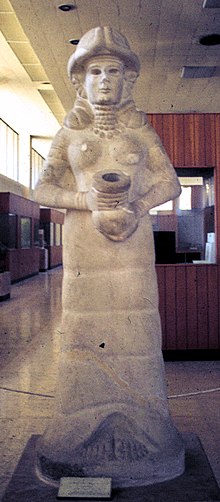Water-bubbling goddess (Mari)
A stone sculpture found in the palace of Zimri-Lim in Mari (Tell Hariri, Syria) , which is now exhibited in the National Museum in Aleppo , is called the water- bubbling goddess ( French : Deesse au vase jaillissant , German goddess with the bubbling vase ) . This is 1.49 meters high and dates to the first half of the 18th century BC. She has a hole inside through which water could be passed, which then gushed out of the vessel in her hand. The figure is identified as a goddess by the crown of horns .
The figure's hair is twisted into two braids and tied up at the neck. The chain hanging around her neck has a counterweight on her back. This counterweight is a special feature that only appeared in the Ur III period. Otherwise, her clothing consists of a floor-length, tiered robe. The statue's eyes were inlaid with a different material and have not been preserved.
A corresponding representation of such a deity is also known from the mural Investiture of Zimrilim from Mari.
literature
- André Parrot : Le palais. ( Mission archéologique de Mari Vol. 2, 3). Geuthner, Paris 1959, pp. 5ff.
- Winfried Orthmann : Assyrian-Babylonian round sculpture. In: Winfried Orthmann: The Old Orient ( Propylaea Art History Bd. 14). Propylaeen Verlag, Berlin 1975, p. 292, plate 160b.
Individual evidence
- ↑ Barthel Hrouda : Middle East I. Mesopotamia, Babylonia, Iran and Anatolia ( Handbook of Archeology ). Verlag CH Beck, Munich 1971, ISBN 3-406-01451-8 , p. 162.
